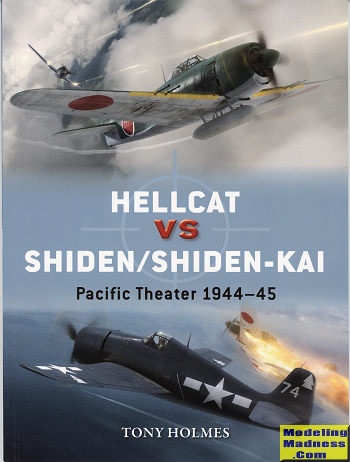 This next
edition of Osprey's Duel series pits two naval fighters against each other in
the last year of WWII in the Pacific. On the American side is the F6F Hellcat
while on the other side is the N1K1-J/N1K2 Shiden/Shiden-kai. These are two
fairly similar aircraft with similar power and flight characteristics.
This next
edition of Osprey's Duel series pits two naval fighters against each other in
the last year of WWII in the Pacific. On the American side is the F6F Hellcat
while on the other side is the N1K1-J/N1K2 Shiden/Shiden-kai. These are two
fairly similar aircraft with similar power and flight characteristics.
The Hellcat was the main carrier borne fighter in the
last years of the war. It was rugged, fairly easy to fly, and well armed. It was
not the fastest fighter in US naval service, that going to the F4U, but the
Corsair was tricky to fly and land on carriers, something the Hellcat was not.
The Hellcat was also fairly maneuverable and by the time it met the adversary of
this book, was a well wrung out weapons system.
The Kawanishi plane, however, was not well wrung out and
thanks to its rather odd beginnings (it was privately developed from a
floatplane fighter), had some major glitches. One of them was a very long and
troublesome main landing gear that had a tendency to break even when only
taxiing. This is not a good thing. It was due to the N1K1-J having the fairly
high mounted wing of the floatplane. The long gear was needed to provide prop
clearance. Given the code name 'George', the Shiden was a plane that handled
well in the air and was heavily armed. It also had pilot and fuel tank armor
protection, something lacking in earlier Japanese fighters. Flown by an
experience pilot, it was more than a match for the Hellcat. It was highly
maneuverable thanks to its automatic combat flaps.
However, the plane needed fixed. The later Shiden-kai,
was almost an entirely new plane with a lower mounted wing, stronger landing
gear and an all cannon armament that provided deadly to those planes hit by it.
Unfortunately for the Japanese, both versions of the George suffered from poor
manufacturing, especially engine issues caused by low octane aviation fuel. The
Shiden-kai was also built in few numbers with less than 300 completed prior to
war's end. The Shiden numbers were not very impressive either. The Hellcat, on
the other hand had over 12,000 examples built by the end of production.
Since the book concentrates on meetings between the
Hellcat and George, there is little in the book on the initial N1K1-J variant
which did see combat against Hellcats over the Philippines and Formosa, but very
few encounters and the type was often misidentified as a Zero. So we get most of
the combat stuff regarding the N1K2 and specifically the 343rd Kokutai, which
was basically a unit made up of skilled pilots and aces. It was felt that this
unit would have the greatest impact. Indeed, it did as the aggression and skill
of its pilots along with an excellent aircraft (when everything was working) was
a nasty surprise to Hellcat units. Fortunately for F6F pilots, there were a lot
more Hellcats than Shiden-kais so what was accomplished by the 343rd really had
very little impact on the outcome of the war.
As is the norm with this series, the authors provide a
bit of background history to the two types as well as a look at how the crews
were trained and how the aircraft were used in combat. One is surprised at how
effective the latter N1K2 aircraft was against a similar number of F6Fs. The
superior maneuverability of the George and its heavy four 20mm cannon armament
were often decisive in the outcome of combat. Where the Hellcat had an advantage
was in its rugged construction and in the sheer numbers. Add to all this some great period photos and superbly
done art work and you'll have an excellent book that is well worth picking up.
February 2019
Copyright ModelingMadness.com. All rights reserved.
For more on the complete line of Osprey books,
visit www.ospreypublishing.com .
If you would like your product reviewed fairly and quickly, please
contact
me or see other details in the
Note to
Contributors.
 This next
edition of Osprey's Duel series pits two naval fighters against each other in
the last year of WWII in the Pacific. On the American side is the F6F Hellcat
while on the other side is the N1K1-J/N1K2 Shiden/Shiden-kai. These are two
fairly similar aircraft with similar power and flight characteristics.
This next
edition of Osprey's Duel series pits two naval fighters against each other in
the last year of WWII in the Pacific. On the American side is the F6F Hellcat
while on the other side is the N1K1-J/N1K2 Shiden/Shiden-kai. These are two
fairly similar aircraft with similar power and flight characteristics.